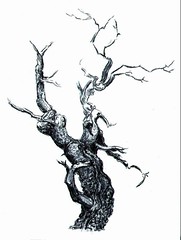ANDRÉ KERTÉSZ, PHOTOGRAPHER
(Born in Hungary in 1894; died in New York City in 1985)
AN INTERVIEW WITH ANDRÉ KERTÉSZA IN FOUR VIDEOS - Watch Them Below
There are many of Kertész's photographs shown in these videos. Don't be put off by the first video because of his difficult-to-understand English. It is definitely worth the trouble of trying to pick up what one can (and the interviewer, as well as the photos shown, do help). You will be glad you were patient when you get to the second and third videos, especially. The second and third time I went back through the interview, I understood what he was saying better and better, and of course I was able to see the photographs again and again.
After Kertész moved to the United States, to New York City, in 1936, his work, in the style he had always worked in, was rejected by magazines here (though his pictures had been published in European magazines) because it was too "human," too "sentimental" and "tells too many stories." Yes, he said, they were right, as that is what his photographs are about, those are the kinds of pictures he took. He said that they wanted photographs that were mechanically perfect, that were "documents," but his were, instead, sensitive and human, and "real."
___
"He left behind him a successful career and many close friends. New York was a disaster. His kind of photography was not understood, and magazines would not print his tender and sober images." (From second video, see below)
___
Nevertheless, he did some magazine work here in the U.S., though not able to fully exercise his unique creativity in the assignments he was given (for example he worked for House and Garden from 1945 to 1962), and he was very disappointed, but he stayed. After he left House and Garden he was finally able to take the kinds of pictures he wanted to again. Now he is recognized as the fine photographer that he was.
Nevertheless, he did some magazine work here in the U.S., though not able to fully exercise his unique creativity in the assignments he was given (for example he worked for House and Garden from 1945 to 1962), and he was very disappointed, but he stayed. After he left House and Garden he was finally able to take the kinds of pictures he wanted to again. Now he is recognized as the fine photographer that he was.
Note that you can watch these videos in a much larger size in the Thinking About Art Library.
André Kertész - Part 1
9 minutes, 55 seconds
When first video finishes, scroll down to the next video
WHEN THIS VIDEO FINISHES, SCROLL DOWN BELOW TO THE NEXT ONE
__________
André Kertész - Part 2
Master Photographers BBC series
10 minutes, 20 seconds
WHEN THIS VIDEO FINISHES, SCROLL DOWN BELOW TO THE NEXT ONE
___________
André Kertész - Part 3
Master Photographers BBC series7 minutes, 33 seconds
WHEN THIS VIDEO FINISHES, SCROLL DOWN BELOW TO THE NEXT ONE
__________
André Kertész - Part 4
Master Photographers BBC series
3 minutes, 53 seconds
__________
Here is another interview with Kertész, which you can read rather than listening to. It appears to be a transcription of a filmed interview. This is quite different than the interview in the videos, above. Almost every bit of this is regarding his experiences with photography from childhood until before he came to the U.S.
An excellent NY Times article on André Kertész (2005)
"Everything is a subject. Every subject has a rhythm. To feel it is the raison d'être. The photograph is a fixed moment of such a raison d'être, which lives on in itself." - André Kertész


0 comments:
Post a Comment